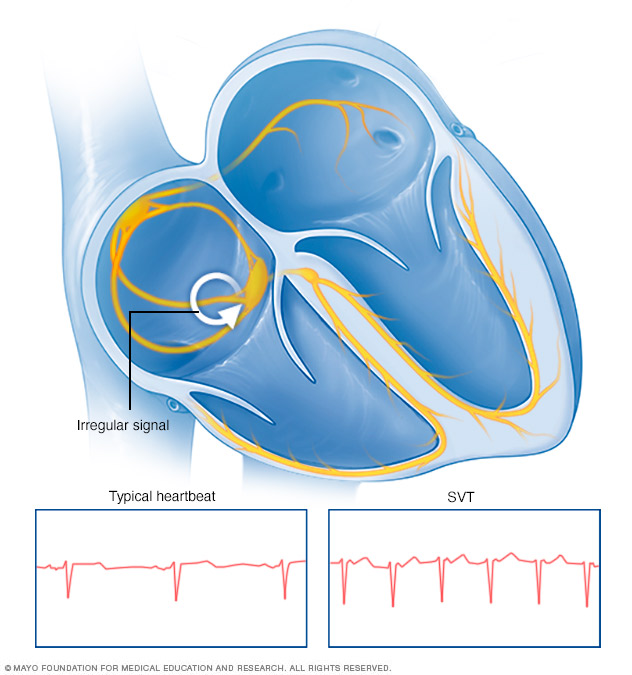Atrioventricular nodal reentry tachycardia (AVNRT)
Overview
Atrioventricular nodal reentry tachycardia (AVNRT) is a type of irregular heartbeat, also called an arrhythmia. It is the most common type of supraventricular tachycardia.
People with AVNRT have an irregularly fast heartbeat that often starts and ends suddenly. In AVNRT, the heart beats more than 100 times a minute. The condition is due to a change in heart signaling. There is an extra pathway for heart signals to travel, called a reentrant circuit. That extra pathway causes the heart to beat too early.
AVNRT tends to occur more often in young women. But anyone can have it at any age. AVNRT may not need treatment. When recommended, treatment may include specific actions or movements, medicines, or a heart procedure.
Diagnosis
Tests used to diagnose atrioventricular nodal reentry tachycardia (AVNRT) may include:
- Blood tests to see how well the thyroid is working and to check for heart disease or other conditions that may trigger an irregular heartbeat.
- Electrocardiogram (ECG) to check the electrical activity of the heart and look at the heartbeat.
- Holter monitor, a heart monitor that you wear during everyday activities, usually for 1 to 2 days. This monitor can find irregular or fast heartbeats that might not occur during a standard electrocardiogram (ECG).
- Echocardiogram, which uses sound waves to make pictures of the heart's size, structure and motion.
A healthcare professional might try to trigger AVNRT with other tests, which may include:
- Exercise stress test, which is typically done on a treadmill or stationary bicycle while the heart activity is watched.
- Electrophysiological study and cardiac mapping, which can show exactly where in the heart an irregular heartbeat starts.
Treatment
Most people with atrioventricular nodal reentry tachycardia (AVNRT) don't need treatment. But if the fast heartbeat occurs often or lasts a long time, treatment may be needed. Treatment for AVNRT may include:
- Vagal maneuvers. Simple but specific actions such as coughing, bearing down as if having a bowel movement, gently massaging the main artery in the neck or putting an ice pack on the face can help slow down the heart rate. These actions affect the vagus nerve, which helps control the heartbeat.
- Cardioversion. Paddles or patches on the chest are used to electrically shock the heart and help reset the heart rhythm. Cardioversion is typically used when vagal maneuvers and medicines don't work.
- Medicines. If the fast heartbeat happens frequently, your healthcare professional may prescribe medicines to slow or control your heart rate.
- Catheter ablation. This treatment may be suggested if medicines don't work or if their side effects are too bothersome. A doctor inserts thin, flexible tubes called catheters through the veins or arteries, usually in the groin. Sensors on the tip of the catheter use heat or cold energy to create tiny scars in the heart. The scars block irregular electrical signals and restore a typical heartbeat.

Supraventricular tachycardia (SVT) is an irregularly fast or erratic heartbeat. It occurs when faulty electrical signaling in the heart set off a series of early beats in the upper chambers of the heart.
Last Updated Feb 17, 2024
© 2024 Mayo Foundation for Medical Education and Research (MFMER). All rights reserved. Terms of Use